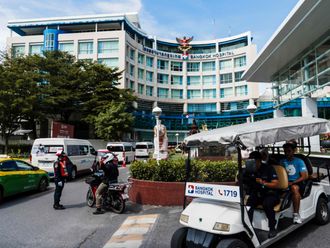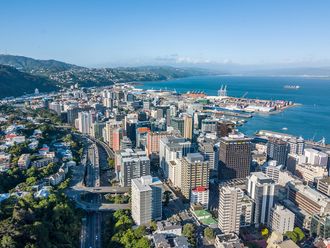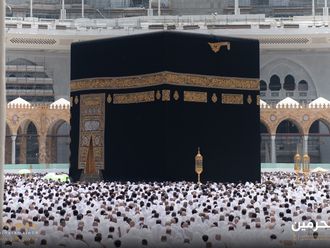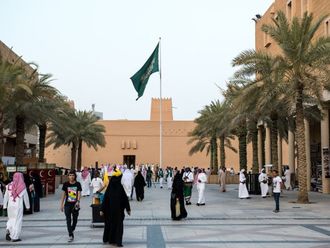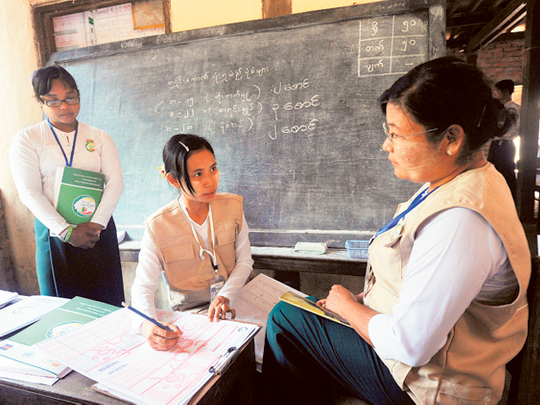
Lin Sun Oo doesn’t take his eyes off the field and forest before him — the rich green grass and the leaves on the lush trees stand, almost obediently, as still as statues. It is quiet. It is motionless. It is going to be the perfect shot, he thinks. To the right of him, his cameraman patiently peers into a viewfinder and, with a few careful adjustments, locks the image into focus.
Before long, a thin pole of a man — an elderly farmer named U Thaung Khaing, whose tanned, wrinkled hands are weathered from decades of working the land in central Myanmar — inches into view. Barefoot and dressed in a brown longyi, white button-down shirt, and straw hat, he glides along a winding dirt path that slices through the dominant green in the shot. The producer exhales. The scene is exactly what he had envisioned — and will be the perfect opener for his upcoming documentary.
In Lin Sun Oo’s film, U Thaung Khaing’s soft voice narrates a moving portrayal of Than Bo Lay, a village in Magway district, where, in 2010, the regime confiscated land from the area’s farmers. During the military’s rule, the regime regularly appropriated property for its development projects, while offering little or no compensation to those who relied on the fields for their livelihoods.
When the 27-year-old documentarian first met the farmer, it seemed the two were equally relieved to have found one another. “We’d found someone who was very articulate and with whom we could have an intimate conversation,” Lin Sun Oo says. “I think it was the first time he had got the chance to explain the impact of their loss of forest to outsiders.”
But this moment represents more than a documentarian telling the story of a farmer who lost his land. It is a snapshot of two Myanmarese citizens — an artist and a villager — enjoying the freedom to speak, criticise and document openly, without fear of retribution from the military that ruled the country from 1962 until just a few years ago. For five decades, government censors gagged not only the news media, but also the film, art, and literature communities. For filmmakers in particular, the use of camcorders without a licence and the unauthorised publishing or screening of recorded material was a criminal act. And, then, in November 2010, Myanmar held elections, the new government instituted reforms, and things began to change.
Today, Lin Sun Oo is among a handful of gutsy Myanmarese who are using motion pictures to push for greater political and historical transparency. Some are new to the film scene while others are climbing up from the underground. The shift heralds a significant revolution for the country’s film industry — and for Myanmar’s understanding of the abuses that its leaders had long concealed.
Although the majority of Myanmarese had never seen one until recently, provocative and artistic films are in Myanmar’s very nature. As early as 1906, 21 years after Britain took control of the entire country, crowds gathered under the stars in Yangon’s narrow back streets to watch grainy images projected onto cotton sheets. But what started as pure theatre evolved into a film scene far more substantial — and political.
By 1920, Britain’s hold on the country was tight. Not only did a small number of British companies dominate the country’s economy, but Indian labourers were brought in to work the country’s jobs, fuelling widespread indigenous unemployment. Film became an outlet for nationalist sentiment. In 1931, Parrot Film Co — led by U Sunny, a hardened patriot unafraid of beaming his anti-British sentiment onto the big screen — debuted “36 Animals”, a film exposing the complicity of the colonial police force in illegal gambling.
Other filmmakers soon began casting a critical eye on British rule in Myanmar. These exposés helped fuel a movement for independence that gathered pace with protests in Yangon and Mandalay by the late 1930s. In 1948, as they shed their colonial possessions in a postwar retrenchment, the British withdrew and Myanmar became an independent democracy.
But Myanmar’s brief flirtation with representative government was cut short by a 1962 coup that left the military in charge. It wasn’t until the 1968 roll-out of the Film Council, an outfit tasked with using cinema to promote the regime’s ultranationalism, that the dictatorship actively constricted artistic freedom, according to Grace Swe Zin Htaik, secretary-general of the Myanmar Motion Picture Organisation. The big screen was soon dominated by films such as 1979’s “Ah Mi Myay Hma Thar Kaung Myar” (Good Sons of the Motherland) — produced by the Office of the Director of Combat Training — in which Myanmarese patriots fended off foreign meddlers.
Myanmarese directors, however, didn’t flinch just yet, and they continued creating films. In the early 1970s, A1 Film, the country’s most prominent production company, shot “Journey to Piya”, a film about a road trip gone wrong — an old vehicle beset with multiple engine breakdowns served as a metaphor for the decade after the coup. This didn’t go over well. And it didn’t take long before the Film Council banned the film and the government put the company’s founder on watch.
Authoritarian rule continued throughout the 1970s and 1980s. General Ne Win, who had led the coup, nationalised private industries and put them in the hands of military leaders. In 1987, on the advice of an astrologer, he announced that only bank notes divisible by nine — an auspicious number for him — would be allowed, causing millions of Myanmarese to lose their savings overnight.
Ne Win resigned the following year, but with the military showing few signs that it would relinquish its grip on the country, hundreds of thousands of people across Myanmar took to the streets in 1988 to demand democratic elections. The military responded with force, and within two months, up to 3,000 people were dead and thousands were behind bars.
Following Ne Win’s resignation, a clique of generals from his inner circle formed a military junta. The State Law and Order Restoration Council, as it was known, continued to use film as a propaganda tool. Myanmar’s all-time highest-grossing film, 1996’s “Thu Chun Ma Kan Bi” (Never Shall We Be Enslaved), which was reportedly funded by the regime, focused on the British Army’s seizure of Mandalay in 1885. Its heroes were a group of army generals who ignored the demands of King Mindon Min to cease resistance against Britain’s conquest of the country. The film was almost euphoric in its depiction of the renegade fighters — an unsubtle lesson in the importance of patriotism.
Decades of economic mismanagement during the Ne Win years followed by enormous military expenditures under the junta further degraded Myanmar’s economy. By 2007, the Myanmarese people were furious: Sky-high fuel prices sparked the monk-led uprising that year in which more than 100 protesters were killed. Three years later, the regime, realising citizen ire was not about to dissipate, held elections and introduced a quasi-civilian government led by President Thein Sein — a general nicknamed “Mr Clean” for his rare ability to avoid corruption scandals — who instituted political and economic reforms in a bid to end sanctions and spur Western investment, all to much applause from the United States and Europe.
For filmmakers, the pivotal moment came in March 2011, when the president, in a speech, emphasised the role of the media in a free society. Almost overnight, independent media became a tool for democracy, where it had long only been viewed as nothing more than seditious and criminal by the regime. In January 2013, when the censorship board was dissolved, journalists, artists and filmmakers were free to produce material without their work being vetted by the once-feared Information Ministry.
Within six months of Thein Sein’s seminal speech, a collective of filmmakers organised the Wathann Film Festival, Myanmar’s first such event. The documentaries it features have grown to become bold, provocative, and critical of the former regime. In 2013, its top documentary prize went to Shin Daewe, who tracked the plight of Myanmarese refugees from Kachin state when they fled to China in 2011 amid fierce fighting between the Myanmarese army and Kachin rebels. Because the government attempts to prevent journalists from entering rebel-held territory, the film offers rare insight into the human costs of this conflict.
Just a few years ago, this work could have landed Shin Daewe a ten-year prison sentence. But now, she is working on a documentary about a major industrial development on Myanmar’s southern coastline that, upon completion, will become Southeast Asia’s largest industrial complex — but that could ultimately displace up to 30,000 people from the bucolic fishing villages that line the Dawei coast.
The budding documentary scene got another boost in January 2012, when Aung San Suu Kyi — chair of the National League for Democracy and a Nobel Peace Prize laureate — hosted the first Art of Freedom Film Festival. Her inaugural speech, along with its coveted endorsement of the festival, signalled the importance of the industry to the democratisation process she has long demanded.
Similar to Wathann, Art of Freedom’s top works have been largely political. One of the most highly acclaimed documentaries featured has been director Sai Kyaw Khaing’s “Click in Fear”, which followed journalist Law Eh Soe as he covertly covered the 2007 uprising. Like the journalists he followed, Sai Kyaw Khaing had been underground, working as a cameraman and producer for the news organisation Democratic Voice of Burma (DVB), a group of activists, political prisoners and rebels turned journalists. Formed in exile in 1992, the collective established a network of journalists inside Myanmar to surreptitiously shoot footage of the abusive military regime. The network would then send the news to DVB’s offices in Thailand and Norway, where the footage would be edited into news segments and transmitted back into Myanmar via radio and, in 2005, satellite TV.
The head organiser of the Wathann Film Fest, known only as Thaiddhi, is also no stranger to illicit journalism. After a cyclone ripped through southern Myanmar and killed up to 140,000 people in 2008, the regime locked down the region, blocking aid to victims, expelling the media, and ramping up surveillance of journalists. Videographers filmed in the delta and went about their work with meticulous care, often splitting off and entering the region with their cameras disassembled and the component parts divided up among them to avoid detection. Thaiddhi and his team wrapped up “Nargis – When Time Stopped Breathing” in 2010, but his documentary, shot in the delta, was illegal, so he couldn’t share it with anyone aside from a close network of friends and journalists inside Myanmar. The filmmaker finally showed his film in Myanmar in 2012.
Thaiddhi says that today Yangon has only a few production houses dedicated to documentary film — but it is a laudable start, given that only three years ago there was none. Most of today’s documentaries are screened only at the independent film festivals such as Wathann, which is now an annual fixture in Yangon. In the festival’s first year, 23 Myanmarese films were screened. Two years later, in 2013, some 2,500 people attended the four-day event, which featured 33 Myanmarese-made films.
The expansion of nonfiction film stands in sharp contrast to the country’s declining commercial film industry — saturated with the Myanmarese version of screwball comedies and love stories — where, in 2012, only 30 per cent of the films in theatres were Myanmarese productions. In the 1970s, when Myanmarese film was at its peak, an average of 70 indigenous films were released every year, according to Grace Swe Zin Htaik. Unlike the laborious and time-consuming documentaries being produced today, the big-screen mainstream films are sometimes cheaply and hastily created in seven days, including postproduction. In 2013, the Myanmar Motion Picture Academy Awards featured 12 award categories, but only 17 films were even considered.
Zay Par, a mainstream film director, sees opportunity in the marriage of fact and fiction. He is creating a feature-length film based on the events surrounding the 1988 uprising. If it makes it to the country’s theatres, it will be the first dramatisation ever produced in Myanmar that deals with politically sensitive subject matter since the dawn of Ne Win’s rule 52 years ago. It will also be the first time the momentous events of 1988 are rendered on the big screen. His intent is deliberate: to meld entertainment and education. “We aim to promote knowledge among oppressed rural villagers — educate them about their rights, encourage them to read more.”
The public’s pent-up appetite for truth is certainly voracious. In the past year, the government has granted dozens of licences for new daily newspapers. These newspapers, as well as foreign papers, such as the International New York Times and the Bangkok Post, are all sold at newsstands. In the past, newsstands were only permitted to sell newspapers and periodicals approved by the government. Papers were printed and then sent to the censors; because it was costly to reprint papers after the censors had redacted information, it was not uncommon to buy a newspaper with large holes actually cut out of some of the pages.
Although the climate of fear for filmmakers has eased, there is still a hangover effect — and of course the ruling party, while elected, is backed by the military. Lin Sun Oo says that on several occasions in 2013, while shooting his documentary, he was followed by plainclothes police officers. “They want you to know you’re being watched, and sometimes they’ll ask where we’re going next,” he says, adding that no action has yet been taken against him. Rather than succumbing to intimidation, he embraces their presence as inspiration. “Sometimes they help find subjects for your story. It’s a matter of getting them to understand why we believe it’s important.”
The uncertainty over how this transitional period will play out pervades all rungs of Myanmarese society, from the military hawks anxious that democracy will dilute the Myanmarese elite’s power to the general population, which knows all too well its rulers’ mercurial nature. Myanmarese filmmakers, however, seem hopeful that they will be able to cast a light where shadows have long stood. Lin Sun Oo is both optimistic and cautious: “I believe that we live in exciting times. We are at the cusp of change, but I am not able to determine what these changes will lead to.”
–Washington Post


